Abstract
Low density polyethylene (LDPE), carbon black (CB), and oil palm empty fruit bunch (OPEFB) fiber composites were prepared by melt blending and compression molded into sheets. The effects of incorporated fibers on the electrical conductivity, thermal conductivity, tensile properties, and thermal degradation of the composites were investigated. FTIR results suggest that the OPEFB fibers interact poorly with the polymer matrix and lead to a decrease in mechanical properties. The electrical conductivity of the composites decreased with increasing OPEFB fiber content. Despite the slight decline in conductivity, the composites still were sufficiently conductive relative to applications such as sensors and electromagnetic shielding after the fiber addition. Reduction in thermal conductivity by as much as 10.9% was observed with the addition of 20% OPEFB fiber into LDPE/CB composites. The thermal stability of LDPE/CB/OPEFB fiber composites decreased with increasing fiber content because of the low thermal stability of the incorporated natural fiber.
Download PDF
Full Article
Effects of Oil Palm Empty Fruit Bunch Fiber on Electrical and Mechanical Properties of Conductive Filler Reinforced Polymer Composite
Jing Lang Choh,a,b Yern Chee Ching,a,* Seng Neon Gan,b Shaifulazuar Rozali,a and Sabariah Julai a
Low density polyethylene (LDPE), carbon black (CB), and oil palm empty fruit bunch (OPEFB) fiber composites were prepared by melt blending and compression molded into sheets. The effects of incorporated fibers on the electrical conductivity, thermal conductivity, tensile properties, and thermal degradation of the composites were investigated. FTIR results suggest that the OPEFB fibers interact poorly with the polymer matrix and lead to a decrease in mechanical properties. The electrical conductivity of the composites decreased with increasing OPEFB fiber content. Despite the slight decline in conductivity, the composites still were sufficiently conductive relative to applications such as sensors and electromagnetic shielding after the fiber addition. Reduction in thermal conductivity by as much as 10.9% was observed with the addition of 20% OPEFB fiber into LDPE/CB composites. The thermal stability of LDPE/CB/OPEFB fiber composites decreased with increasing fiber content because of the low thermal stability of the incorporated natural fiber.
Keywords: Oil palm empty fruit bunch fiber; Conductive polymer composite; Electrical conductivity; Mechanical properties
Contact information: a: Department of Mechanical Engineering, Faculty of Engineering, University of Malaya, 50603 Kuala Lumpur, Malaysia; b: Department of Chemistry, Faculty of Science, University of Malaya, 50603 Kuala Lumpur, Malaysia; *Corresponding author: chingyc@um.edu.my
INTRODUCTION
Polymers are generally recognized as electrical and thermal insulators. Certain conductive fillers, such as metal powders or fibers, carbon black, synthetic graphite, carbon nanotubes, and carbon fibers, can be added to an insulating polymer matrix to enhance and tailor the conductivity of polymer composites (Huang 2002; Kamarudin et al. 2013). Conductive polymer composites have received considerable attention from academia as well as industry in recent decades (Pang et al. 2014). The conductive resins have some superior properties compared to metals, such as being lightweight, having resistance to corrosion and good processing ability, and having the ability to manipulate the conductivity properties to suit application needs. For example, electrically conductive polymer composites may be suitable for electromagnetic interference or radio frequency interference shielding applications, static charge dissipating materials, conducting adhesives in electronic packaging, and self-regulating heaters (AL-Oqla et al. 2015).
Carbon-based fillers are excellent conductive fillers for polymer composites because of their high thermal and electrical conductivity, great corrosion resistance, and lower thermal expansion coefficient than metals (Hong et al. 2010). At the present time, carbon black filled polymers are widely used because of their cost advantage over many other types of conductive fillers, such as carbon nanotubes and metals. Carbon blacks are generally amorphous forms of carbons that have similar structures to disordered graphite (Huang 2002). They are commonly used in tires, wires, cables, and the automobile and aviation industries. The addition of carbon black to polypropylene (PP) and polyethylene (PE) is used to improve weathering resistance and alter the dielectric properties of the composites (Dubey et al. 2014). However, large amounts of carbon black may bring some drawbacks, such as difficulty in processing and deteriorated mechanical properties of the final composite material. Furthermore, cost/performance balance is also an important aspect to consider in actual applications.
Environmental issues such as sustainability of materials and eco-efficiency have received much attention in recent decades. These issues have led to interest in research concerning natural materials such as natural fibers extracted from cultivated plants and their polymer composites. Various fibers from natural sources, such as flax, hemp, jute, sisal, kenaf, banana, and coconut, have been used to reinforce polymers (Joseph and Thomas 2008; Gelfuso et al. 2011; John et al. 2012; Ali et al. 2014; Chee et al. 2013; Nurfatimah et al. 2014; Ching et al. 2015; Nurfatimah et al. 2015; Yong et al. 2015a,b). These natural fibers have advantages over conventional polymer fillers such as their low cost, abundance, light weight, comparable specific properties, non-abrasion to processing equipment, non-irritation to the skin, and bio-degradability (Joseph and Thomas 2008; Ku et al. 2011; Ali et al. 2014; Tan et al. 2015a, Tan et al. 2015b).
In the past few years, there have been some research works conducted on the electrical and dielectric properties of natural fiber reinforced polymer composites ( Jacob et al. 2006; Sreekumar et al. 2012; George et al. 2013). The studies showed improvement in electrical conductivity and dielectric constant with the incorporation of natural fibers. However, the conductivity values of the composites with natural fibers are not comparable to conventional conductive polymer composite, where the conductive polymer composites have higher conductivity values by several magnitudes than the fiber reinforced composites. Thus, this might limit the potential of the bio-composites in electronic applications.
Haseena et al. (2007) compared the electrical conductivity of sisal/coir hybrid fiber reinforced natural rubber composites with different chemical modifications on the fiber. Chemical treatments such as alkaline treatment, acetylation, benzoylation, and permanganate treatment were investigated in their research. The study concluded that the composite with untreated fiber is more conductive than other chemical-treated fiber composites. This is due to the removal of polar cellulosic hydroxyl (-OH) groups that are present in the fiber, thus reducing the moisture absorption and leading to a decrease in orientation polarization of the fibers (Haseena et al. 2007).
A recent work by Li et al. (2015) has developed an eco-friendly vapor sensor by incorporating ramie fibers into conductive polymer composites. According to the authors, the conductive fillers in the composite aggregate and form a conductive network along the ramie fiber. The addition of ramie fibers increases the sensing stability of vapor sensors without sacrificing its electrical properties (Li et al. 2015). This may open up the possibility of using the cellulosic material in other electronic applications.
Research activities have been extensively carried out to prepare conductive polymer composites that are inexpensive and have suitable conductivity for various applications. The current study aimed to examine the effects of oil palm empty fruit bunch fiber addition with various loadings on the properties of carbon black filled polyethylene composite. This work focused on the characterization of electrical conductivity, thermal conductivity, as well as mechanical and thermal stability properties of the prepared composites.
EXPERIMENTAL
Materials
Low-density polyethylene (LDPE) resin (Cosmothene G811) was purchased from The Polyolefin Company (Singapore) Pte Ltd. Carbon black (CB) was selected as a conductive filler, and oil palm empty fruit bunch (OPEFB) fiber was used as a natural fiber filler in the hybrid polymer composites. Carbon black (CB) masterbatch (Black F-30940MM) with a weight ratio of 40 wt% black solid content was obtained from DIC compounds (Malaysia) Sdn. Bhd. OPEFB fibers were supplied by Sabutek (Malaysia) Sdn. Bhd. The OPEFB fibers were sieved using a Retsch sieve shaker (Retsch, Germany) to separate the powders into different sizes. OPEFB fibers with the diameter between 125 and 250 µm were used in this study.
Preparation of Polymer Composites
To study the effect of fiber on the conductive composites, LDPE and CB had a constant ratio of 7:3, and the mass ratio of OPEFB fiber to the whole system was varied. The addition of fiber into LDPE/CB composites ranged from 5 wt% to 20 wt% of the whole system. The compositions of the samples are summarized in Table 1. The materials were introduced into a Brabender® 350S internal mixer (Brabender® GmbH & Co., Germany) at 115 °C and 60 rpm for 15 min. Then, the composites were compression molded into 1-mm-thick samples by a Gotech (GT 7014 – A) hot press machine (Gotech, Taiwan) at 125 °C for 12 min, followed by 3 min of cooling under pressure to room temperature.
Table 1. Compositions of Prepared LDPE/CB/OPEFB Fiber Composites

Characterization
Fourier transform infrared spectroscopy (FTIR)
The prepared composites were analyzed using a FT-IR/FT-FIR spectrometer (Perkin Elmer, Spectrum 400, USA). The FTIR scans were carried out for wavelengths from 4000 cm-1 to 400 cm-1 at the resolution of 4 cm-1 and recorded after 32 unit scans.
Electrical conductivity
Impedance measurements were conducted using a Hioki 3532-50 LCR Hi Tester (Hioki, Japan) in the frequency range between 42 Hz and 5 MHz at room temperature. The polymer composite samples were sandwiched between two stainless steel electrodes of a conductivity holder with a diameter of 1.6 cm. The Cole-Cole plots were plotted and the value of bulk resistance (Rb) was estimated from the plots. Electrical conductivity (σ) was calculated using the following equation,
![]()
where t is the thickness of samples and A is the contact area between electrode and electrolyte.
Thermal conductivity
The thermal conductivity of the specimen was measured using a P.A. Hilton H940 heat conduction unit (P.A Hilton Limited, United Kingdom). The apparatus applied a guarded heat flow method according to ASTM E1225-04. The specimen were cut from the compression molded sample into circular disc shapes with about 1 mm thickness and 25 mm in diameter and placed between the two brass terminals of the conduction unit for thermal conductivity measurements. The hot terminal was supplied with a constant power of 7 W, while the cold terminal was cooled by water circulating at a constant rate of 2 L min−1.
The system was left up to 3 h until steady-state conditions were achieved, where the temperature change was within ± 0.1 °C/min. The temperatures at hot terminals (T1, T2, and T3) and cold terminals (T4, T5, and T6) were measured by thermocouples. Then, the values of T1 through T6 were extrapolated to obtain the temperatures at the interfaces of the hot (Th) and cold (Tc) ends of the specimen. The temperature readings were taken every 10 min when the system was about to reach its steady-state condition, and the average of the last three temperature measurements was used to calculate the effective thermal conductivity, Kc, of the samples using the following equations:
![]()
where KC = effective thermal conductivity (W/mK) of the sample; ∆ZC = the length (m) of the sample; A = contact area of the sample = 4.91 × 10-4 m2 ; = temperature (K) difference across the sample; and = average heat input (W), which can be defined as below:
![]()
where,
Heat flow in hot zone (W), ![]() (4)
(4)
Heat flow in cold zone (W), ![]() (5)
(5)
Tensile properties
The tensile properties of prepared composites were tested using a Shimadzu universal tensile machine (Shimadzu, Japan) according to the ASTM D-638-02a method. Tensile strength, elongation at break, and Young’s modulus were obtained. The grip separation speed of the tensile tests was set at 12.5 mm/min. Five tensile measurements were carried out for each composition, and the average results are reported.
Thermogravimetric analysis (TGA)
Thermogravimetric analyses (TGA) of LDPE and its composites was evaluated by TGA 851 (Mettler-Toledo, Greifensee, Switzerland). Approximately 10-mg samples were heated at a rate of 20 °C/min under air flow from 40 to 800 °C to obtain thermogravimetric (TG) curves.
RESULTS AND DISCUSSION
FTIR
FTIR analysis was carried out to provide insight on the interactions between fillers and the LDPE polymer matrix. The FTIR spectra of LDPE and PE/CB/EFB composites are shown in Fig. 1. Neat LDPE exhibited its characteristic peaks at 2916, 2849, 1463, and 719 cm-1, which correspond to asymmetry stretching, symmetry stretching, deformation, and rocking of C-H bonds, respectively.
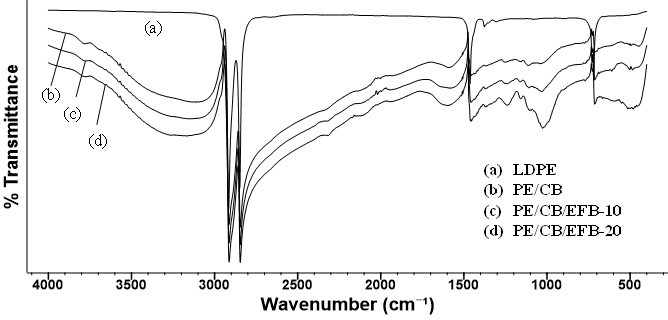
Fig. 1. FTIR spectra of LDPE and PE/CB/EFB composites with various compositions
The spectra for the carbon black filled composites exhibited a broad absorption region because of the strong absorbing nature of carbon black (Wen et al. 2012). There are many chemisorbed oxygen complexes, such as phenolic, quinonic, and carboxylic groups, present on the surface of carbon blacks (O’Reilly and Mosher 1983). These complexes caused some characteristic changes to the FTIR spectrum. The additional absorption peak at 1593 cm-1 was observed and attributed to highly conjugated C=O stretching (O’Reilly and Mosher 1983). The broad absorption region between 2950 and 3600 cm-1 was due to overlapping of O-H stretching and =C-H stretching frequencies from the surface functional groups of carbon black (Rositani et al. 1987). The transitions from 1000 to 1400 cm-1 were contributed by C-O stretching frequencies of COOH groups (O’Reilly and Mosher 1983). Also, the addition of carbon blacks also led to a shift of the LDPE characteristic peaks toward lower wavenumbers. This shift suggests that interaction occurs between LDPE and carbon black particles.
The further addition of OPEFB fibers into PE/CB resulted in an additional adsorption peak near 1030 cm-1, which can be attributed to stretching of C-O groups in the OPEFB fibers (Ku et al. 2011; Monteiro et al. 2012). The intensity of this peak increased with increasing fiber content, which confirmed the presence of cellulosic fibers in the composites. The interactions between OPEFB fibers and LDPE matrix were weak and did not cause significant shifting of LDPE characteristic peaks. Low matrix-fiber adhesion can be explained by the difference in polarity behavior of the components, where LDPE is hydrophobic and OPEFB fiber has a hydrophilic nature (Ku et al. 2011; Monteiro et al. 2012).
Electrical Conductivity
Electrical conductivity measures the ability of a material to conduct electric current. Carbon black acts as conductive filler and was dispersed into the LDPE matrix by a melt blending process. Pure LDPE is an electric insulator, where the conductivity value of neat LDPE is reported to be lower than 10-13 S/cm, depending on its grade, density, processing conditions, and other parameters (Hong et al. 2006; Dudić et al. 2011; Sabet et al. 2012; Fim et al. 2013). Carbon black particles will aggregate and form a continuous conducting path above its critical concentration, thus producing polymer composites that are conductive (Huang 2002). The increase in polymer conductivity with carbon black is over 10 orders of magnitude higher compared to the neat polymer (Gupta et al. 2006; Dudić et al. 2011; Ibarrola et al. 2013).
Impedance measurements were used to analyze the electrical properties of the composites. Figure 2 shows the Cole-Cole plots obtained from the experiments. The Cole-Cole plot, also known as Nyquist plot or complex impedance plot, shows the imaginary part of impedance, Zi, plotted against the real part of impedance, Zr. All of the samples exhibited a semicircle pattern in the plot. The semicircles were distinguished in their diameter, where the samples that exhibited a larger semicircle diameter were correlated with more resistive samples. The interception of the semicircles on the real axis of impedance, Zr, corresponds to the direct current (DC) resistance and was taken as the bulk resistance, Rb, of the samples (Gupta et al. 2006).

Fig. 2. Cole-Cole plots for the PE/CB and PE/CB/EFB composites
The electrical conductivity of the samples was calculated by substituting the Rb values obtained from the Cole-Cole plots into Eq. 1. Figure 3 shows the electrical conductivity at room temperature of PE/CB/EFB composites with various loadings of OPEFB fibers. The electrical conductivity for PE/CB was 1.9 ´ 10-4 S/cm, and the addition of OPEFB fiber to the PE/CB caused a decrease in its electrical conductivity. The conductivity values for composites that contained 5%, 10%, 15%, and 20% OPEFB fiber were 9.6 ´ 10-5 S/cm, 7.8 ´ 10-5 S/cm, 6.1 ´ 10-5 S/cm, and 3.6 ´ 10-5 S/cm, respectively. A declining trend for electrical conductivity of PE/CB/EFB composites with increasing fiber loading was observed. Some researchers have reported an increase in electrical conductivity with increasing fiber content in polymer/natural fiber composites (Sreekumar et al. 2012; George et al. 2013). The polar groups in the composite increased with increasing fiber content and led to an increment in orientation polarization. Moisture is also absorbed by the hydrophilic fibers, which increases the current flows in non-crystalline region of the polymer composite. Thus, the flow of current was facilitated and an enhancement in conductivity was observed (George et al. 2013). However, declining conductivity values were recorded with the addition of natural fiber into PE/CB conductive polymer composites in this study. For PE/CB/EFB composites, conductivity behavior can be attributed to the conducting path formed by carbon black particles in the polymer matrix. The effect of fibers’ polar groups on the conductivity was less significant compared with the conducting carbon black particles. Furthermore, the effective composition of carbon black in the composite was also reduced by the addition of OPEFB fiber into the composite, which led to the reduction of electrical conductivity.
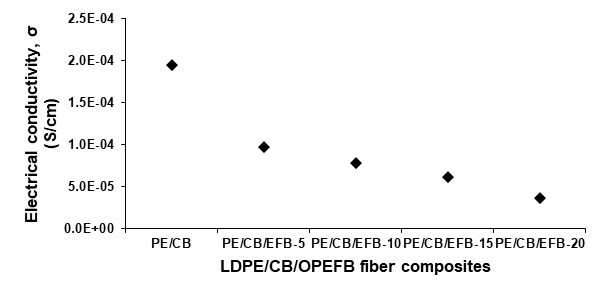
Fig. 3. Electrical conductivity, σ (S/cm), of PE/CB/EFB composites with various compositions
The examples of applications for conductive polymer composites with various electrical resistivity ranges are summarized in Table 2, where the resistivity, p, is the reciprocal of
![]() (6)
(6)
Table 2. Resistivity (Ω cm) of Conductive Polymer Composites and their Applications (Pang et al. 2014)

Table 3 shows the resistivity values for prepared composites. The resistivity of the samples ranged from 5.2 ´ 103 to 2.7 ´ 104 Ω cm, where all of them can be categorized as conductive composites. Despite the conductivity reductions, the composites with and without natural fibers still have the possibility of having the same application fields, as their electrical resistivity values fall in the same range.
Table 3. Resistivity (Ω cm) of PE/CB and PE/CB/EFB Composites

Thermal Conductivity
The ability of a material to transport heat is called its thermal conductivity. The effective thermal conductivity of the samples was calculated by the procedure mentioned previously. Figure 4 demonstrates the thermal conductivity of various types of samples. It clearly indicates that the addition of carbon black into a LDPE matrix will enhance its thermal conductivity, which ranges from 0.47 W/mK for pure LDPE to 0.55 W/mK for the PE/CB composite. Carbon-based materials such as carbon black have a higher intrinsic thermal conductivity compared with polymers and can form conductive pathways in the polymer matrix. Thus, heat can be conducted through the composite more effectively and lead to a higher thermal conductivity for the composites compared with that of neat polymer.
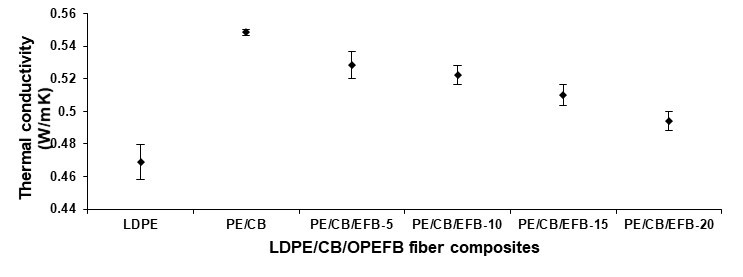
Fig. 4. Thermal conductivity (W/mK) of LDPE and PE/CB/EFB composites with various compositions
In contrast, addition of OPEFB fibers into the composite reduced its thermal conductivity by a maximum of 10.9% for the composite with 20% OPEFB fibers compared with the PE/CB composite without the presence of fiber. The PE/CB/EFB composites showed a decreasing trend for thermal conductivity with increasing volume fraction of OPEFB fiber in the composite. A similar trend was reported when natural fibers were added to a polymer matrix (Li et al. 2008; Monteiro et al. 2012; Alam et al. 2014). Natural fibers have lower thermal conductivity than polymers and are not able to provide a conductive path for heat energy in composite materials (Monteiro et al. 2012). Furthermore, natural fibers contain lumens, which are hollow cylindrical structures encompassing cavities that will hinder heat transport in composites (John et al. 2012). The fiber addition might be applicable when a higher thermal insulation effect is desired while retaining the other properties of the composites.
Tensile Properties
The tensile strength of the various samples is shown in Fig. 5. There was an increase in tensile strength observed when carbon black was integrated into the LDPE matrix, where the tensile strength improved from 7.49 MPa for neat LDPE to 10.15 MPa for PE/CB. Improvement in tensile strength of polymers with carbon black addition also has been reported by other researchers (Khalil et al. 2007; Liang and Yang 2008).
The addition of OPEFB fibers to PE/CB composites reduced the tensile strength. The tensile strength decreased with increasing fiber loading in the studied range, with a tensile strength minimum at 5.76 MPa for PE/CB/EFB-20. This suggests that the hydrophilic fibers and non-polar hydrophobic LDPE might be incompatible. The weak interaction between OPEFB fibers and polymer matrix is also described by the FTIR results. This caused an inefficient stress transfer from the matrix and thus reduced the tensile strength of PE/CB/EFB composites.
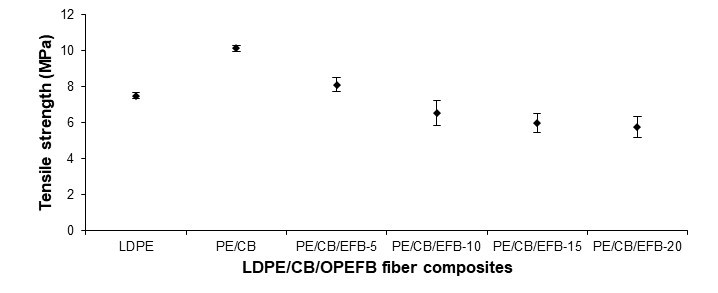
Fig. 5. Tensile strength (MPa) of LDPE and PE/CB/EFB composites with various compositions
Figure 6 illustrates the trend of elongation at break (%) when various compositions of OPEFB fiber were added to PE/CB composites. The elongation for pure LDPE is not shown in this figure to enable a better comparison for the rest of samples, as the pure LDPE had 164% elongation at break, which was much higher than all the other composites. The addition of 30% carbon black to LDPE caused its elongation to be reduced markedly. The weak interfacial adhesion between the LDPE matrix and the OPEFB fiber caused a discontinuity of the matrix and reduction in elongation at break (Ali et al. 2014). A sharp drop of elongation with carbon black addition to polypropylene and polycarbonate composites has also been reported (Huang 2002).
The elongation at break of the composites decreased noticeably, from 9.4% to 3.9%, upon the addition of the first 5% of fiber filler into PE/CB. After that, the elongation decreased gradually with further OPEFB fiber addition until it reached a minimum value of 1.3% for the PE/CB/EFB-20 composite. The fibers reduced the polymer chain mobility and caused the polymer composites to lose their toughness (Nurfatimah et al. 2015). A decrease in elongation of polymer composites upon the addition of natural fiber fillers is also in agreement with other researchers’ work (Ku et al. 2011; Yong et al. 2015a).
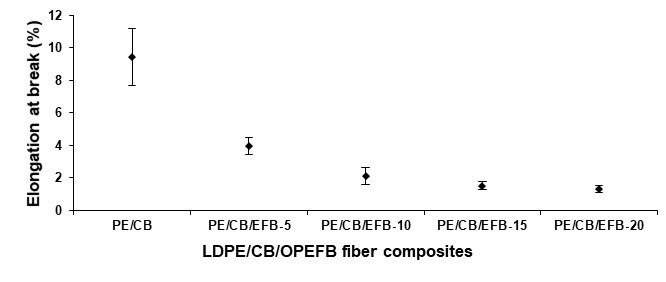
Fig. 6. Elongation at break (%) of LDPE and PE/CB/EFB composites with various compositions
Young’s modulus, also known as tensile modulus, correlates with the stiffness of a composite. The Young’s moduli for the various samples are shown in Fig. 7. The addition of carbon black to the LDPE matrix increased the Young’s modulus by 237%. The increase in interactions between LDPE-LDPE, LDPE-CB, and CB-CB molecules may lead to the enhancement in Young’s modulus. This also suggests that the carbon black particles were well dispersed in LDPE and had large surface contacts with the LDPE matrix, thus resulting in a higher Young’s modulus value (Alam et al. 2014).
Further enhancement of the modulus was recorded with increasing OPEFB fiber content, reaching a maximum at 570 MPa for the composite composed of 20% fibers. The enhanced interaction among the molecules was associated with Young’s modulus value. The incorporation of rigid fiber fillers in the soft LDPE matrix formed a stiffer composite and thus led to the enhancement of tensile modulus (Cao et al. 2011).
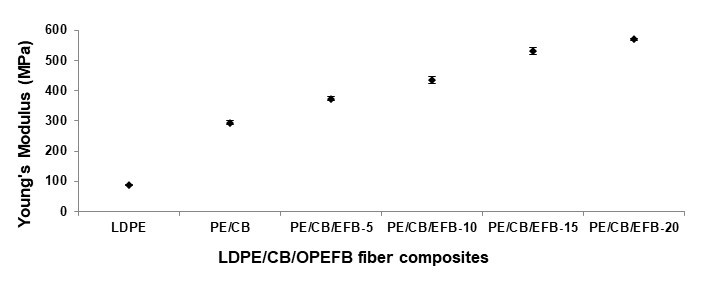
Fig. 7. Young’s modulus (MPa) of LDPE and PE/CB/EFB composites with various compositions
Thermogravimetric Analysis (TGA)
Thermogravimetric analysis (TGA) was conducted for the prepared composites from room temperature to 800 °C, at a heating rate of 20 °C/min, under air flow. The mass loss of the samples during heating is displayed as the thermogravimetric (TG) curve to give insight on their thermal degradation properties. Figure 8 shows the thermal degradation of pure LDPE and PE/CB/EFB composites with various OPEFB fiber contents. During the thermal degradation, pure LDPE showed a single degradation step, while the other samples exhibited two degradation steps, consisting of a main degradation step and a minor degradation step.
The onset temperature, To, of the degradation is the intersection point of tangents to two branches of the TG curve and was obtained from the TGA software. Decomposition temperature at 50% mass loss, T50, and onset temperature, To, that corresponded to the main degradation step were used to evaluate the decomposition of LDPE and its composites. T50 and To for the samples are tabulated in Table 4.
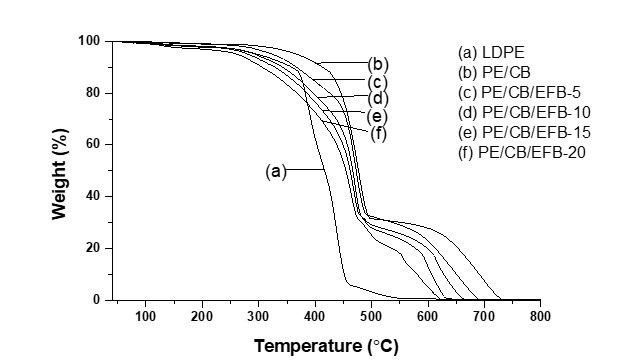
Fig. 8. TGA curves of LDPE and PE/CB/EFB composites with various compositions
Table 4. Onset Temperature, To (°C), and Temperature at 50% Mass Loss, T50 (°C), for the Main Degradation Step of Prepared Composites

The effects of carbon black addition on the degradation behavior were evaluated by comparing the thermal degradation of pure LDPE and PE/CB. The main degradation step exhibited in the TG curves corresponded to the breakdown of the LDPE backbone. To increased from 372.31 °C for LDPE to 450.18 °C for the PE/CB composite, while T50 also increased by as much as 60 °C. The presence of carbon black in the LDPE polymer matrix enhanced the thermal stability of the composite. During the degradation process, volatile degraded LDPE components were adsorbed on the carbon black surface, which may have delayed the mass loss and retarded the thermal degradation. In addition, the mobility of resin molecules, restricted by the surrounding carbon black, might have caused the degradation process to become slower (Alam et al. 2014). An increased thermal stability of polymer composites with the addition of carbon black filler has been reported elsewhere (Dittrich et al. 2013; Alam et al. 2014) and agrees with these findings. The PE/CB exhibited one more degradation step at above 550 °C, which was attributed to the degradation of carbon black components in the composite.
Thermal degradation behavior for PE/CB and PE/CB/EFB composites was compared to assess the influence of fiber addition on the thermal stability of the polymer composites. The TG curves of all the PE/CB/EFB composites possess a similar pattern, with a shift to lower temperatures as fiber content increased.
The decomposition of the composites with 10%, 15%, and 20% OPEFB fibers started with a minor mass loss near 120 to 140 °C, which was attributed to the loss of moisture from natural fibers in the composites. This decomposition step was not remarkable for the PE/CB/EFB-5 composite because of its low fiber composition. Afterward, major mass loss was observed for all the PE/CB and PE/CB/EFB composites from approximately 250 to 490 °C. This main decomposition step can be ascribed to the breakdown of LDPE and components from OPEFB fibers. The To of the main decomposition step decreased with increasing fiber content in the composite, which decreased for about 28 °C at 20% fiber loading compared to composites without fibers, whereas T50 also decreased, from 476.67 °C for PE/CB to 454.33 °C for PE/CB/EFB-20. Degradation of the fiber components in PE/CB/EFB composites started at a lower temperature than the degradation of LDPE itself. For the compounds in natural fibers, the decomposition of hemicellulose and pectin occurred from approximately 240 to 340 °C, followed by cellulose degradation from approximately 340 to 490 °C (Monteiro et al. 2012). As the fiber content in the composites increased, greater mass loss was detected at lower temperatures, which led to the shifting TG curves. Polymer chain scission might also have occurred because of interactions such as friction between the fibers and polymer, which might have led to lower thermal stability. The decrease in thermal stability of polymer composites with the addition of natural fibers has been reported by other researchers (Singha et al. 2013; Nurfatimah et al. 2015). Subsequently, decomposition of carbon black occurred above 500 °C under air flow.
CONCLUSIONS
- The electrical conductivity of the composites decreased as the fiber loading increased because of the reduction of the effective carbon black content in the composites. Nevertheless, the reduction in electrical conductivity did not cause a major drawback because all of the composites can still be applied in the same applications.
- A declining trend in thermal conductivity was observed with increasing OPEFB fiber loading, which was due to the insulating properties of natural fibers.
- The increasing fiber content in PE/CB/EFB composites had a negative influence on tensile strength and elongation of the composite. On the other hand, the tensile modulus was enhanced with increasing fiber loading, with an increase by up to 95% at 20% fiber loading compared to that of the PE/CB composites.
- FTIR analysis revealed that there were interactions between LDPE and carbon black, which caused a shift in LDPE characteristic peaks with the inclusion of carbon black. However, further addition of OPEFB fibers into PE/CB composites exhibited poor matrix-filler interactions and caused a decrease in tensile strength and elongation at break.
ACKNOWLEDGEMENTS
The authors would like to acknowledge the financial support of the High Impact Research MoE Grant UM.C/625/1/HIR/MoE/52, FP053-2015A and FP030-2013A from the Ministry of Education of Malaysia and research grants University of Malaya – RP024C-13AET, RU022A-2014, and RG031-15AET for the success of this project.
REFERENCES CITED
AL-Oqla, F. M., Sapuan, S., Anwer, T., Jawaid, M., and Hoque, M. (2015). “Natural fiber reinforced conductive polymer composites as functional materials: A review,” Synthetic Metals 206, 42-54. DOI: 10.1016/j.synthmet.2015.04.014
Alam, M. K., Islam, M. T., Mina, M. F., and Gafur, M. A. (2014). “Structural, mechanical, thermal, and electrical properties of carbon black reinforced polyester resin composites,” Journal of Applied Polymer Science 131(13), 40421. DOI: 10.1002/app.40421
Ali, M. E., Yong, C. K., Ching, Y. C., Chuah, C. H., and Liou, N.-S. (2014). “Effect of single and double stage chemically treated kenaf fibers on mechanical properties of polyvinyl alcohol film,” BioResources 10(1), 822-838. DOI: 10.15376/biores.10.1.822-838
ASTM D638-02a. (2002). “Standard test method for tensile properties of plastics,” ASTM International,” ASTM International, West Conshohocken, PA. DOI: 10.1520/D0638-02A
ASTM E1225-04. (2004). “Standard test method for thermal conductivity of solids by means of the guarded-comparative-longitudinal heat flow technique,” ASTM International, West Conshohocken, PA. DOI: 10.1520/E1225-04
Cao, X. V., Ismail, H., Rashid, A. A., Takeichi, T., and Thao, V. H. (2011). “Mechanical properties and water absorption of kenaf powder filled recycled high density polyethylene/natural rubber biocomposites using MAPE as a compatibilizer,” BioResources 6(3), 3260-3271. DOI: 10.15376/biores.6.3.3260-3271
Chee, C. Y., Yong, G. K., Abdullah, L. C., and Nadarajah, K. (2013). “Effect of nanosilica and titania on thermal stability of polypropylene/oil palm empty fruit fibre composite,” Journal of Biobased Materials and Bioenergy 7(1), 169-174. DOI: 10.1166/jbmb.2013.1281
Ching, Y. C., Rahman, A., Ching, K. Y., Sukiman, N. L., and Cheng, H. C. (2015). “Preparation and characterization of polyvinyl alcohol-based composite reinforced with nanocellulose and nanosilica,” BioResources 10(2), 3364-3377. DOI: 10.15376/biores.10.1.1519-1527
Dittrich, B., Wartig, K. A., Hofmann, D., Mulhaupt, R., and Schartel, B. (2013). “Flame retardancy through carbon nanomaterials: Carbon black, multiwall nanotubes, expanded graphite, multi-layer graphene and graphene in polypropylene,” Polymer Degradation and Stability 98(8), 1495-1505. DOI: 10.1016/j.polymdegradstab.2013.04.009
Dubey, K. A., Sinha, S. K., Bhardwaj, Y. K., Panicker, L., and Varshney, L. (2014). “Carbon black-Filled PE/PP/EPDM blends: Phase selective localization of carbon black and EPDM-induced phase stabilization,” Polymer-Plastics Technology and Engineering 53(5), 442-450. DOI: 10.1080/03602559.2013.844832
Dudić, D., Škipina, B., Dojčilović, J., Novaković, L., and Kostoski, D. (2011). “Effects of charge trapping on the electrical conductivity of low‐density polyethylene–carbon black composites,” Journal of Applied Polymer Science 121(1), 138-143. DOI: 10.1002/app.33421
Fim, F. d. C., Basso, N. R., Graebin, A. P., Azambuja, D. S., and Galland, G. B. (2013). “Thermal, electrical, and mechanical properties of polyethylene–graphene nanocomposites obtained by in situ polymerization,” Journal of Applied Polymer Science 128(5), 2630-2637. DOI: 10.1002/app.38317
Gelfuso, M. V., Silva, P. V. G. d., and Thomazini, D. (2011). “Polypropylene matrix composites reinforced with coconut fibers,” Materials Research 14(3), 360-365. DOI: 10.1590/s1516-14392011005000056
George, G., Joseph, K., Nagarajan, E. R., Tomlal Jose, E., and George, K. C. (2013). “Dielectric behaviour of PP/jute yarn commingled composites: Effect of fibre content, chemical treatments, temperature and moisture,” Composites Part A: Applied Science and Manufacturing 47, 12-21. DOI: 10.1016/j.compositesa.2012.11.009
Gupta, S., Ou, R., and Gerhardt, R. A. (2006). “Effect of the fabrication method on the electrical properties of poly (acrylonitrile-co-butadiene-co-styrene)/carbon black composites,” Journal of Electronic Materials 35(2), 224-229. DOI: 10.1007/bf02692439
Haseena, A., Unnikrishnan, G., and Kalaprasad, G. (2007). “Dielectric properties of short sisal/coir hybrid fibre reinforced natural rubber composites,” Composite Interfaces 14(7-9), 763-786. DOI: 10.1163/156855407782106582
Hong, J., Schadler, L., Siegel, R., and Mårtensson, E. (2006). “Electrical behavior of low density polyethylene containing an inhomogeneous distribution of ZnO nanoparticles,” Journal of Materials Science 41(18), 5810-5814. DOI: 10.1007/s10853-006-0331-1
Hong, J., Park, D. W., and Shim, S. E. (2010). “A review on thermal conductivity of polymer composites using carbon-based fillers: Carbon nanotubes and carbon fibers,” Carbon Letters 11(4), 347-356. DOI: 10.5714/CL.2010.11.4.347
Huang, J.-C. (2002). “Carbon black filled conducting polymers and polymer blends,” Advances in Polymer Technology 21(4), 299-313. DOI: 10.1002/adv.10025
Ibarrola, J. M. A., López, S. H., Santiago, E. V., Alanis-Pérez, J., and Valverde, M. I. P. (2013). “Experimental study of the processing parameters of polymer conductive semicrystalline polymer composites with carbon black: Optimizations and reproducibility,” Journal of Thermoplastic Composite Materials 28(4), 574-590. DOI: 10.1177/0892705713486136
Jacob, M., Varughese, K. T., and Thomas, S. (2006). “Dielectric characteristics of sisal–oil palm hybrid biofibre reinforced natural rubber biocomposites,” Journal of Materials Science 41(17), 5538-5547. DOI: 10.1007/s10853-006-0298-y
John, M. J., Tlili, R., Anandjiwala, R. D., Boudenne, A., and Ibos, L. (2012). “Effect of amphiphilic coupling agent on heat flow and dielectric properties of flax–polypropylene composites,” Composites Part B: Engineering 43(2), 526-532. DOI: 10.1016/j.compositesb.2011.11.016
Joseph, S., and Thomas, S. (2008). “Electrical properties of banana fiber-reinforced phenol formaldehyde composites,” Journal of Applied Polymer Science 109(1), 256-263. DOI: 10.1002/app.27452
Kamarudin, M. A., Sahamir, S. R., Datta, R. S., Long, B. D. , Sabri, M. F. M. and Said, S. M . (2013). “A review on the fabrication of polymer-based thermoelectric materials and fabrication methods,” The Scientific World Journal 17. DOI: 10.1155/2013/713640
Khalil, H. A., Noriman, N., Ahmad, M., Ratnam, M., and Fuaad, N. N. (2007). “Polyester composites filled carbon black and activated carbon from bamboo (Gigantochloa scortechinii): Physical and mechanical properties,” Journal of Reinforced Plastics and Composites 26(3), 305-320. DOI: 10.1177/0731684407065066
Ku, H., Wang, H., Pattarachaiyakoop, N., and Trada, M. (2011). “A review on the tensile properties of natural fiber reinforced polymer composites,” Composites Part B: Engineering 42(4), 856-873. DOI: 10.1016/j.compositesb.2011.01.010
Li, X., Tabil, L. G., Oguocha, I. N., and Panigrahi, S. (2008). “Thermal diffusivity, thermal conductivity, and specific heat of flax fiber–HDPE biocomposites at processing temperatures,” Composites Science and Technology 68(7-8), 1753-1758. DOI: 10.1016/j.compscitech.2008.02.016
Li, Y., Liu, H., Dai, K., Zheng, G., Liu, C., Chen, J., and Shen, C. (2015). “Tuning of vapor sensing behaviors of eco-friendly conductive polymer composites utilizing ramie fiber,” Sensors and Actuators B: Chemical 221, 1279-1289. DOI: 10.1016/j.snb.2015.07.100
Liang, J.-Z., and Yang, Q.-Q. (2008). “Mechanical properties of carbon black-filled high-density polyethylene antistatic composites,” Journal of Reinforced Plastics and Composites 28(3), 295-304. DOI: 10.1177/0731684407081376
Monteiro, S. N., Calado, V., Rodriguez, R. J. S., and Margem, F. M. (2012). “Thermogravimetric behavior of natural fibers reinforced polymer composites—An overview,” Materials Science and Engineering: A 557, 17-28. DOI: 10.1016/j.msea.2012.05.109
Nurfatimah, B., Ching, Y. C., Luqman, C. A., Chantara, T. R. and Nor, A. (2014). “Effect of methyl methacrylate grafted kenaf on mechanical properties of polyvinyl chloride/ethylene vinyl acetate composites,” Composites Part A 63, 45-50. DOI: 10.1016/j.compositesa.2014.03.023
Nurfatimah, A. B., Ching, Y. C., Luqman, C. A., Chantara, T. R., and Nor, A.I. (2015). “Thermal and dynamic mechanical properties of grafted kenaf filled poly (vinyl chloride)/ethylene vinyl acetate composites,” Materials and Design 65, 204-211. DOI: 10.1016/j.matdes.2014.09.027
O’Reilly, J., and Mosher, R. (1983). “Functional groups in carbon black by FTIR spectroscopy,” Carbon 21(1), 47-51. DOI: 10.1016/0008-6223(83)90155-0
Pang, H., Xu, L., Yan, D.-X., and Li, Z.-M. (2014). “Conductive polymer composites with segregated structures,” Progress in Polymer Science 39(11), 1908-1933. DOI: 10.1016/j.progpolymsci.2014.07.007
Rositani, F., Antonucci, P., Minutoli, M., Giordano, N., and Villari, A. (1987). “Infrared analysis of carbon blacks,” Carbon 25(3), 325-332. DOI: 10.1016/0008-6223(87)90002-9
Sabet, M., Hassan, A., and Ratnam, C. T. (2012). “Mechanical, electrical, and thermal properties of irradiated low-density polyethylene by electron beam,” Polymer Bulletin 68(9), 2323-2339. DOI: 10.1007/s00289-012-0741-y
Singha, A. S., Rana, A. K., and Jarial, R. K. (2013). “Mechanical, dielectric and thermal properties of Grewia optiva fibers reinforced unsaturated polyester matrix based composites,” Materials and Design 51, 924-934. DOI: 10.1016/j.matdes.2013.04.035
Sreekumar, P. A., Saiter, J. M., Joseph, K., Unnikrishnan, G., and Thomas, S. (2012). “Electrical properties of short sisal fiber reinforced polyester composites fabricated by resin transfer molding,” Composites Part A: Applied Science and Manufacturing 43(3), 507-511. DOI: 10.1016/j.compositesa.2011.11.018
Tan, B. K., Ching, Y. C., Gan, S. N., and Shaifulazuar, R. (2015a). “Biodegradable mulches based on poly(vinyl alcohol), kenaf fiber, and urea,” BioResources 10(3), 5532-5543. DOI:10.15376/biores.10.3.5523-5543
Tan, B. K., Ching, Y. C., Poh, S. C., Luqman, C. A., and Gan, S. N. (2015b). “A review of natural fiber reinforced poly(vinyl alcohol) based composites: Application and opportunity,” Polymers 7(11), 2205-2222. DOI:10.3390/polym7111509
Wen, X., Wang, Y., Gong, J., Liu, J., Tian, N., Wang, Y., Jiang, Z., Qiu, J., and Tang, T. (2012). “Thermal and flammability properties of polypropylene/carbon black nanocomposites,” Polymer Degradation and Stability 97(5), 793-801. DOI: 10.1016/j.polymdegradstab.2012.01.031
Yong, C. K, Ching, Y. C., Chuah, C. H., and Liou, N. S. (2015a). “Effect of fiber orientation on mechanical properties of kenaf-reinforced polymer composite,” BioResources 10(2), 2597-2608. DOI: 10.15376/biores.10.2.2597-2608.
Yong, C. K., Ching Y. C., Mohamad, A., Lim, Z. K., and Chong, K. E. (2015b). “Mechanical and thermal properties of chemical treated oil palm empty fruit bunches fiber reinforced polyvinyl alcohol composite,” Journal of Biobased Materials and Bioenergy 9(2), 231-235. DOI: 10.1166/jbmb.2015.1519
Article submitted: September 7, 2015; Peer review completed: October 24, 2015; Revised version received: November 11, 2015; Accepted: November 13, 2015; Published: December 3, 2015.
DOI: 10.15376/biores.11.1.913-928
